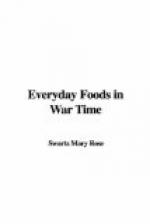A third step in the program of economy is the reduction of the amount of meat consumed. In many American families at least one-third the food money is spent for meat. That there are adequate substitutes which may be used to reduce the amount of meat bought has been already shown. Saving of meat is one of the most important planks in the food conservation program; so here again there is no inevitable conflict between conservation and economy. Some meat is desirable for flavor if it can possibly be afforded, but no economically inclined person should set aside more than one-fourth to one-fifth of the food money for it. How much one will get depends upon the kind and cut selected. There is not so much difference in the nutritive value as there is in the cost, as the following examples of “meat scores” will show:
Meat Score value and fish per pound
Beef, lean round 1,664 Beef, medium fat rump 1,221 Beef, porterhouse steak 1,609 Veal, lean leg 1,539 Lamb, medium fat leg 1,320 Fowl 1,453 Codfish, salt 1,710 Codfish, fresh[2] 519 Salmon, canned 1,074
[2] The low score of fresh
cod is due chiefly to the absence
of fat and the presence of water.
The great value of milk in the diet has already been discussed. The “score” of milk is about the same as that for sugar (milk, 761; sugar, 725); hence, if sugar is ten cents a pound and milk eighteen-cents a quart (about nine cents per pound), milk is cheaper than sugar. Yet there are people cutting down their milk supply when the cost is only thirteen or fourteen cents per quart on the ground that milk is too expensive! The economical housewife should have no compunctions in spending from one-fifth to one-fourth of her food money for this almost indispensable food. Whether the free use of milk will be good food conservation as well as good economy depends upon the supply. If there is not enough to go around, babies and the poor should have the first claim upon it and the rest of the world should try to get along with something less economical.
A pound of eggs (eight or nine eggs) gives about the same nutritive return as a pound of medium fat beef, but to be as cheap as beef at thirty cents a pound, eggs must not cost over forty-five cents a dozen. Eggs must be counted among the expensive foods, to be used very sparingly indeed in the economical diet. Nevertheless the use of eggs as a means of saving meat is a rational food conservation movement, to be encouraged where means permit.
The saving of sugar, while a necessary conservation measure, is contrary to general food economy, since sugar is a comparatively cheap fuel food and has the great additional value of popularity. Sugar substitutes are not all as cheap as sugar by any means, but molasses, on account of its large amount of mineral salts, especially of calcium, has a score value of 2,315 as against 725 for granulated sugar, and may be regarded with favor by those both economically and patriotically inclined.




